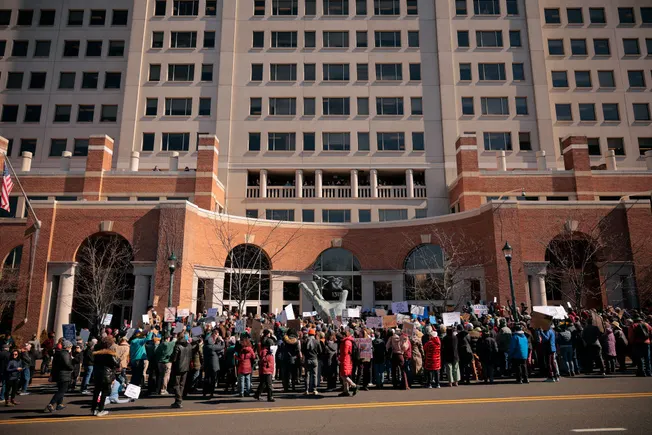With the election of Donald Trump, the myth of the good government job may be disintegrating. Since the inauguration in late January, more than 120,000 federal workers have been fired, per CNN analysis of FedScope data.
One of the hallmarks of the Trump administration has been the Elon Musk-led Department of Government Efficiency, which has publicly gutted federal agency workforces in the name of recouping operating costs. As a result, Indeed reported last month that the number of applications by workers at federal agencies under DOGE review rose by 50%.
Notably, “the data isn’t restricted just to people who have lost their job,” Cory Stahle, economist at Indeed’s Hiring Lab, told HR Dive. “We’re looking at displaced federal workers, but also workers who are still currently employed.”
Not only is Indeed seeing an uptick in applications from federal workers, but recent click activity is “even stronger” than the comparable spikes during the government shutdown that began at the end of 2018 and reached into 2019, Stahle said.
As hundreds of thousands of workers look for new temporary or permanent roles, recruiters in Washington, D.C., and beyond have an opportunity to tap in to this fresh talent pool. But why and how should HR take advantage of that?
New implications for screening and recruitment
This means a bigger talent pool, according to an April 9 SHRM webinar on the federal workforce. And this influx of workers to the public sector isn’t limited to those based in the D.C.-Maryland-Virginia (DMV) area.
Analysis from Indeed Hiring Lab showed that 80% of active federal worker profiles on Indeed are located outside of the DMV.
The most recent data from Office of Personnel Management indicates that while the DMV combined has the largest share of federal workers, other regions have a considerable federal workforce.
By the numbers: Shares of federal workers by state
117,180
Texas’s share of nonpostal federal workers
87,736
Florida’s share of nonpostal federal workers
74,048
Georgia’s share of nonpostal federal workers
62,136
Pennsylvania’s share of nonpostal federal workers
47,526
New York’s share of nonpostal federal workers
52,114
Ohio’s share of nonpostal federal workers
46,500
North Carolina’s share of nonpostal federal workers
Compare the amount of federal workers in Texas to places like Virginia (147,358), Washington, D.C. (162,489) and Maryland (144,497).
“One thing to keep in mind is that, yes, that means you have more talent available to you for some of those roles, but it means that the screening and recruitment process could be overtaxed,” said James Atkinson, SHRM’s VP of thought leadership. His advice is to “[account] for that potential influx of new qualified applicants as well. It could change your time-to-fill implications as well as your hiring decisions as a result.”
Hundreds of demonstrators gather to protest against DOGE cuts outside the headquarters of the National Oceanic and Atmospheric Administration on March 3, 2025.
Chip Somodevilla via Getty Images
Some may be surprised to know that this workforce hails from Ohio, New York and Pennsylvania as much as the DMV, and that federal talent encompasses almost every industry. For example, in Texas, the federal workforce comprises more than 9,000 nurses, nearly 6,000 IT managers and almost 4,000 HR managers, per CNN analysis of OPM data.
Moreover, the job market may be flush with qualified — and possibly overqualified — candidates. Indeed’s Hiring Lab showed that nearly 70% of federal workers have a bachelor’s degree or higher qualification.
How HR can attract federal workers
The best way to recruit former and potentially soon-to-be-former federal employees seems to be recreating or even beating that “good government job” trope.
Regarding the myth of what federal jobs represented, Stahle acknowledged that people have often sought a role in the public sector because it would be a “stable” job with “decent health insurance.”
SHRM’s advice was similar: “Consider benefits flexibility” was one of three key aspects of their best practices for recruiting.
“As your employers are looking at compensation, I think it’s going to be good for them to assess [that] federal workers tend, in a lot of cases, to make less money than maybe a private sector counterpart would — but they have pretty good benefits,” Stahle said. “A lot of these federal workers are going to be very savvy when it comes to thinking about their compensation.”
For example, Indeed’s economist found that federal workers tended to be interested in remote and flexible working arrangements.
“If you’re an employer looking to attract some of these workers, you know, obviously offering some of those things [is] going to potentially help you to stand out,” Stahle said.






Leave a Reply